Last week the Loch Lomond and Trossachs National Park Authority’s Board approved their third Annual Update on the camping byelaws for Scottish Ministers (see here item 6). They still describe this as “Your Park” – an insult to the dozens of people, anglers for example, who used to camp freely along the loch shores enjoying their recreation but are now unable to do so.
While the information provided for Scottish Ministers is far from complete, it should be sufficient to demonstrate to those Ministers that the byelaws are continuing to fail. The explanation for this failure, as Parkswatch has consistently argued, is that they are fundamentally flawed in both concept and design. Unfortunately, the way the Annual Update Report is written demonstrates that the LLTNPA is trying to sweep facts aside and get the byelaws accepted as something permanent. In doing so they are undermining all what a National Park should be about.
Where is the three year review of the camping byelaws?
As well as the Annual Update Report, just approved by the Board, the LLTNPA was required by Scottish Ministers to provide a formal report on the operation of the camping byelaws after three years:
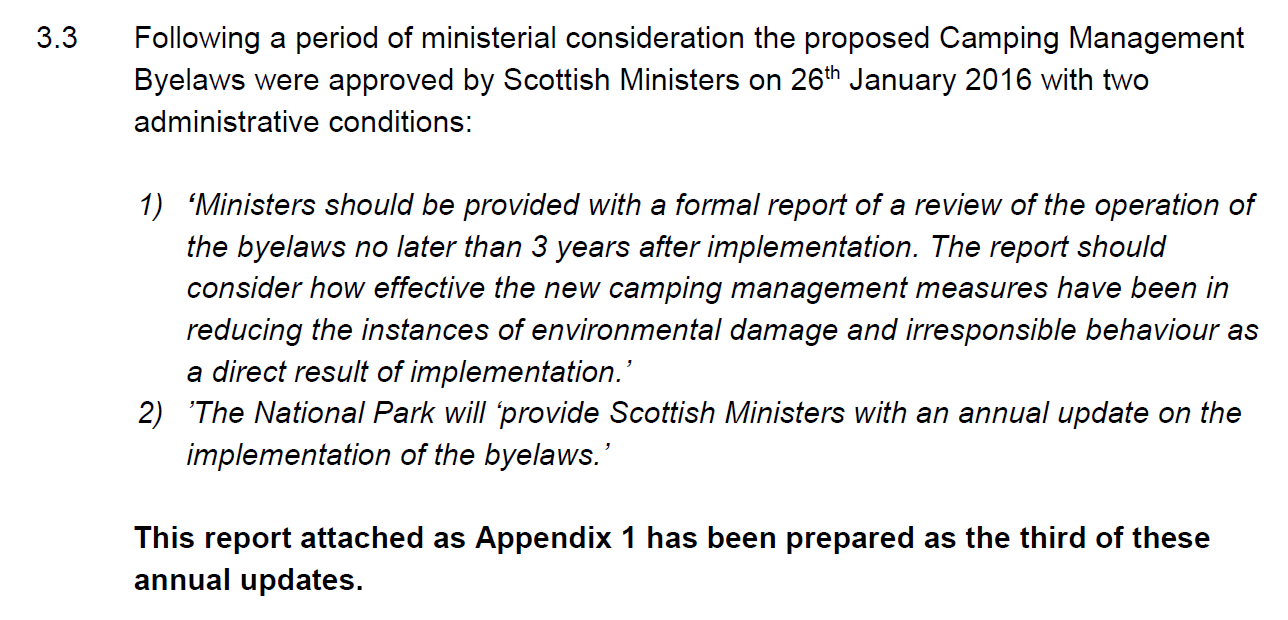
This administrative condition required that report to Ministers to be delivered “no later than three years after implementation” i.e before 1st March 2020, which would mark the start of the fourth year of the camping byelaws. A further paragraph in the Update Report confirms this:
“Further to this update Scottish Ministers will be provided with a report no later than three years after implementation of the byelaws, by March 2020”
However, with the next Board Meeting scheduled for 16th March, and with a reference being made at the meeting last week to the 3 Year Review being discussed then, it appears that the LLTNPA intends to breach this Ministerial condition. Not a single Board Member questioned this at the meeting. It is therefore not clear who actually made the decision to breach the Ministerial requirement, was this senior staff or a coterie of senior Board Members. Whoever, they should be held to account but unfortunately this Board appears incapable of doing so.
The truth is the LLTNPA decided long ago to continue with the camping byelaws whatever the evidence said. As a consequence they see the Review as being irrelevant, a tick box exercise. This is made clear at the end of the report:
“Looking ahead to 2020 and the fourth operational year of the Camping Management Byelaws we will also focus on:…………..”
Not a single qualm about planning for the fourth year of the camping byelaws before they have collected the evidence and presented this to the Minister to show if they are working or not. An example of appalling governance
The legal provisions which govern byelaws by our National Parks are contained in the Local Government (Scotland) Act 1973. These require byelaws to be reviewed at least once every ten years:

The only explanation is that the LLTNPA is treating the requirement by the Minister to review the camping byelaws after three years as a DIFFERENT type of review to that set out in section 202A above. If that is the case, it would be interesting to know if the Scottish Government has agreed to this? Most people will find it hard to understand why Scottish Ministers would require a review into the effectiveness of the camping byelaws after three years if they had already decided there was no possibility of them being changed.
Further information in the Update Report demonstrates that the process for evaluating and reviewing the camping byelaws is a complete shambles:

How does a five year monitoring programme fit with either the three year or even a ten year review? The truth is it won’t make any difference because since the LLTNPA had only collected “some” data BEFORE the byelaws were implemented, they will never be able to provide much valid evidence about whether the camping byelaws have been effective or not, whatever the review period.
The impact of the camping byelaws

Guess what? Litter, human faecal waste and fires were the three main issues used to justify the creation of the camping byelaws. The LLTNPA has so far provided NO evidence that these problems have reduced since the creation of the camping byelaws and indeed is unlikely to be able to do so because it has little objective data pre-dating the byelaws (it relied on photos to sell the byelaws to the public and Minsters). What does seem to have happened is that by concentrating campers into a few places, they have in some respects made problems worse. Its good the LLTNPA is now considering other approaches but that tells you the camping byelaws were never the solution in the first place.
Failure by the LLTNPA to provide the places it promised for camping
“I welcome the Park’s assurances on the provision of an initial 300 camping places by this date and the addition of more provision in subsequent years which forms part of the Park’s Camping Development Plan. ” (Extract Ministerial Letter approving the byelaws)
The LLTNPA failed to deliver sufficient places on time which is why the Update Report re-writes the Ministerial requirement and claims they were required to deliver “300 camping spaces in the first year of the byelaws operating [i.e AFTER the start date rather than BEFORE it as stated by the Minister], with more to be added in subsequent years”
The information in the Update Report confirms that since then the LLTNPA has FAILED to deliver camping further places as it promised:
“In addition to private sector campsites, 300 low cost camping places (a mixture of camping permit areas and low cost campsites) across four Camping Management Zones were available”
So, after three years, still only 300 places. A terriblefailure to deliver.
Part of the reason for this is that many of the camping and permit places the LLTNPA has “created” have not always been available:

These problems were entirely predictable and are accounted for by the LLTNPA creating many of its permit areas in places scarcely fit for use In the case of the Loch Achray the LLTNPA’s own Planning Committee dismissed objections from the Scottish Environment Protection Agency to the construction of a campsite there on the grounds it was located on a flood plain (see here) – and contrary to the Park’s own guidance to boot!
The Report then claims 327 places were available by 30th September, a paltry increase for three years, but a figure that conceals the true position:
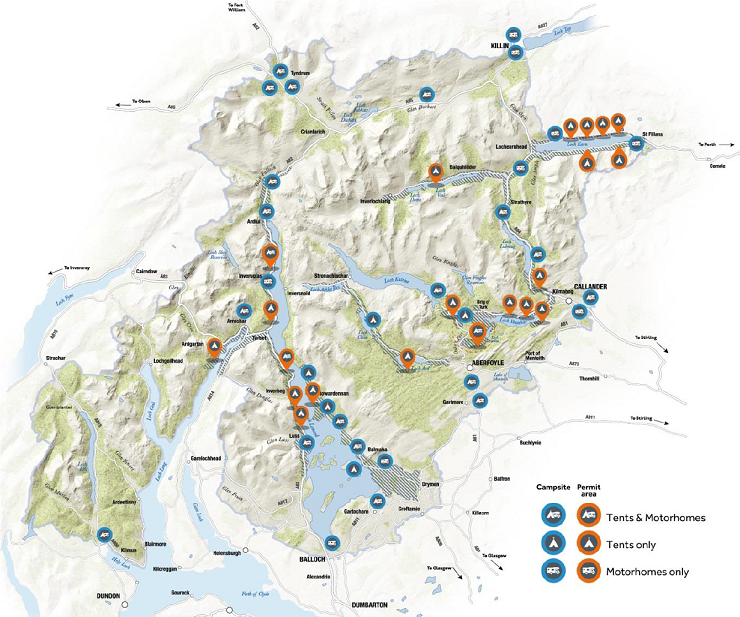
The Report states that 1st March 2019 there were “45 permit areas across the four Camping Management Zones” and, “Of these, 35 were designated for tent camping and 10 were provided for motorhomes”. The breakdown of camping versus campervan places is not given BUT its pretty clear if you take the campervan places out there are significantly less than 300 places to camp, including the two campsites at Loch Chon and Loch Achray. The Ministerial Letter approving the byelaws endorsed the need for 300 CAMPING PLACES at the start of the first year and said nothing campervanning places. Better campervanning provision is sorely needed but the LLTNPA is using the allocation of spaces for campervans to book – they should not be called permit areas at all as campervans can stop off still anywhere by the road in the camping management zones – to mask its failure to provide sufficient camping places.
Reasons for the LLTNPA’s failure to provide camping places
The report confirms that the longstanding problems the LLTNPA has had in delivering its campsite projects on time and on budget continues.

And,
“The installation of a borehole at Loch Chon campsite alleviated the water supply problems experienced in previous seasons, helping provide a more consistent experience and fresh water supply for campers. It was frustrating that the water supply at Loch Achray campsite suffered from capacity issues and a temporary solution in the form of a bowser was used to maintain a good service for customers. A solution will be sought to increase capacity for the 2020 season”.
After failing to open a year earlier as originally planned the Board was then told that all would be ready for the 1st of March. Clearly it wasn’t. My suspicion is that some of these issues relate to staff turnover and vacancies in the Estates Department. However, the failure to plan low cost campsites (Loch Achray cost £370k for 17 places) or control costs – the new bore hole at Loch Chon cost a further £9,925 (see here for FOI response on costs) -has acted as a constraint on the provision of further facilities, which is what has always been needed.
The Update report also reveals (para 4.3) that during the year the LLTNPA gave up trying to create more permit places ostensibly because of cost:
“Additional permit areas were investigated but were found not to be cost effective for the level of provision they offered.”
Camping under access rights is free and costs our public authorities nothing. So how come the National Park is judging new permit areas on whether they are “cost effective” or not? Could the answer be that, having banned camping, landowners can now name whatever price they want before agreeing to a new permit area?
That this is the likely explanation is confirmed by another comment: “Some site specific additional signs were installed when requested by landowners in conjunction with the National Park Ranger Service and Access Officers.”
This appears to be a National Park for landowners, not the rest of us – something the Minister needs to challenge.
The demand for camping places
The Update report tries to justify its failure to provide more camping “places” by claiming they aren’t needed:
“It was decided with current occupancy levels meeting demand for the majority of the time, even in peak periods and with the timescale and complexity for locating suitable new permit areas, then not to seek any additional permit capacity for 2019”.
Again, not a single Board Member questioned this at the meeting.
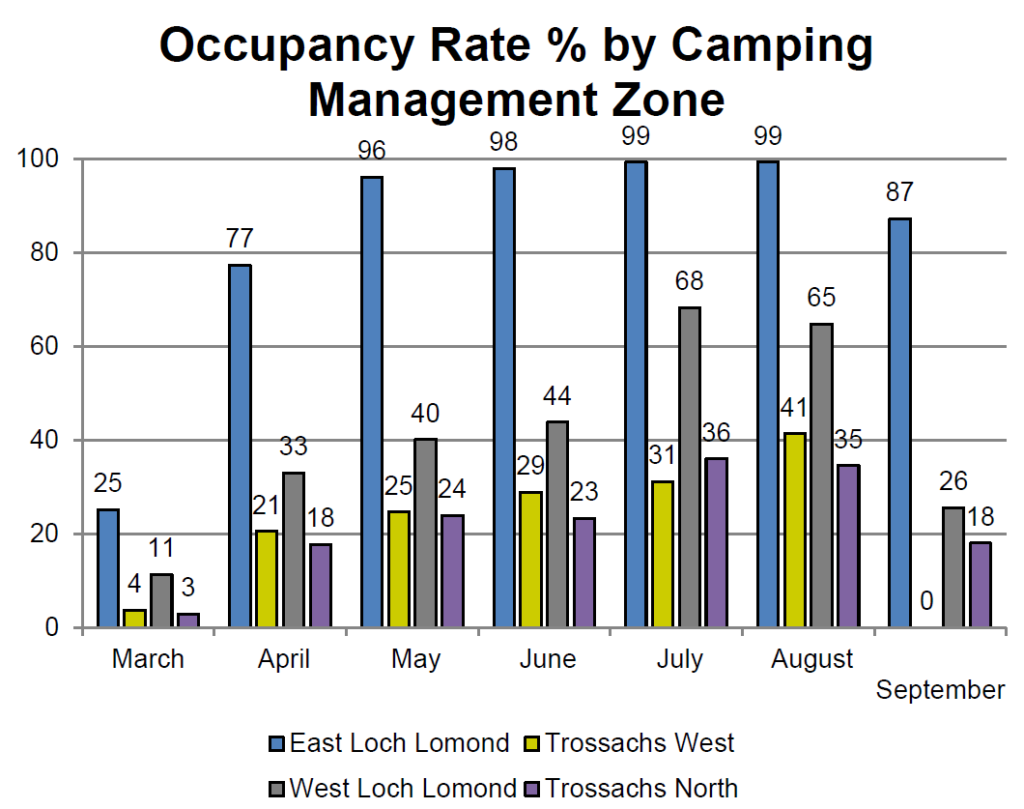
The numbers of people camping on the loch shores in the National Park has always been highly variable – as the Update Report acknowledges – with the weather being the greatest determinant but other factors playing into this, from the fishing season to when people walk long distance routes. The total number wanting to camp greatly exceeds the 300 places allowed for by the LLTNPA on a few weekends of the year and during holidays when the weather is good, but overall “demand” is normally lower than this. Indeed overall demand has probably dropped as former regular visitors such as anglers are now banned from staying at the places they used to camp.
The occupancy figures for the Loch Chon and Loch Achray campsites, at 39% and 28% respectively, bear this out. The contrast, however, between these campsites and with east Loch Lomond (its not clear if the Sallochy campsite has been included in the figures for permit areas or not), which was almost fully booked out from May – August is striking. The explanation of the differences is quite simple, day in day out there are backpackers on the West Highland Way whereas the number of people who used to camp in Strathard used to be very few. What’s happened is the LLTNPA has forced people to stay in campsites out of sight and in areas where there was little demand – in order to try and fulfil its promise to Ministers – but not developed facilities where they are needed.
While its very wrong to determine the total number of places where people are allowed to camp by occupancy, what the occupancy figures should tell Ministers is where facilities for campers would have most effect. The LLTNPA should be judged on their failure to deliver that.
Facilities for campervans
This is the first Annual Update to Ministers which reports any improvement in provision for campervans, the chemical waste disposal point at Tarbet, even if this was delivered after the end of the camping byelaw “season”.
While campervans don’t need a permit to stay in a camping management zone and the permit effectively functions as a tourist tax, the data on who booked permits is extremely interesting. 24% of all permit booking were by campervanners rather than campers:
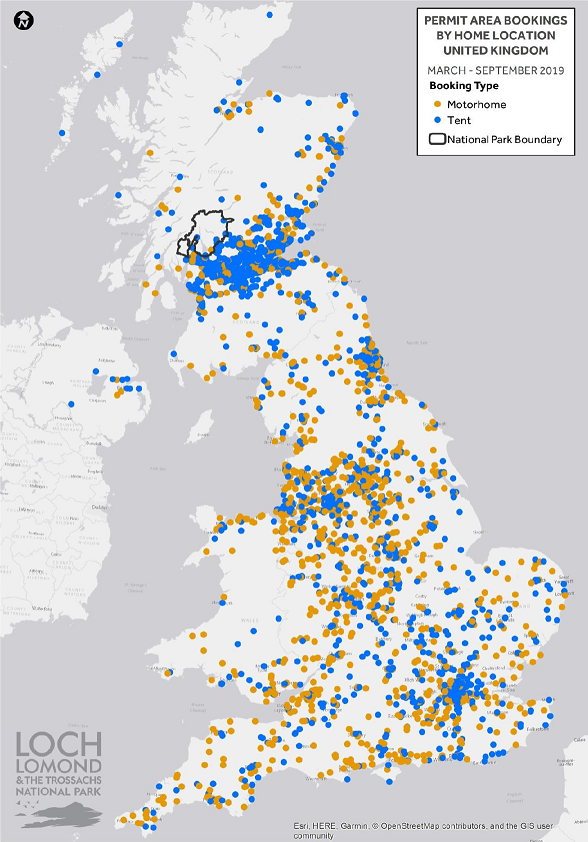
If you consider that only a minority of campervanners are likely to stop off in permit areas, this provides incontrovertible evidence of the need to invest in new infrastructure to support campervanners. With budgets under the cosh, the only way the LLTNPA is likely to be able to meet that demand is to stop wasting money on trying to stop people camping by the loch shores.
Enforcement of the Camping byelaws

That the LLTNPA had to take the names of 735 campers shows that many people are still ignoring the byelaws and the fact that only 8 have been referred to the Procurator Fiscal (as was clarified at the meeting) shows that the main issue is not campers acting irresponsibly in terms of the Scottish Outdoor Access Code, its simply that lots of people don’t want to camp where the LLTNPA tells them to camp. People, thankfully, are acting as though freedom to roam still exists in the National Park.
I suspect that for the 3 Year Review for Ministers the LLTNPA will try and argue that since the names of 931 people and 12 cases were referred to the Procurator Fiscal in 2018, compared to 735 and 8 this year, that more people are now observing the byelaws and this shows they are – albeit very slowly – starting to work. Such an argument, however, needs to explain the following:
- First why the permit feedback form shows “44% of respondents had met a National Park Ranger during their stay, compared to 48% in 2018″ . It appears there has been a drop in ranger patrols – the report refers to a “revised deployment model” – and this alone may account for the drop in the number of people found contravening the camping byelaws.
- Second, the numbers don’t stack up. Elsewhere in the Update Report it is claimed 23,810 camped in a permit area and 4620 at the two campsites in 2019. The total is 28,430 compared to the 28,000 quoted above.
- Third, the figure of 28,430 takes no account of people camping outwith authorised sites in the camping management zones, whether permit areas or campsites. The basic information the LLTNPA need to release is how many people it found camping outside an authorised area and of these, how many names were taken. This won’t show the whole picture because many people camping outwith permit areas are never “caught” and second because the more sensible Rangers often turn a blind eye, for example on east Loch Lomond where it is often impossible to book somewhere “lawful” to camp because of lack of capacity.
In my view there is NO evidence after 3 years of the byelaws to show they are becoming accepted and the implication is, that if they continue, the LLTNPA will be forced to continue to waste scare resources enforcing them, resources that could be much better used elsewhere.
The about turn by the LLTNPA on whether the numbers camping are a problem or not
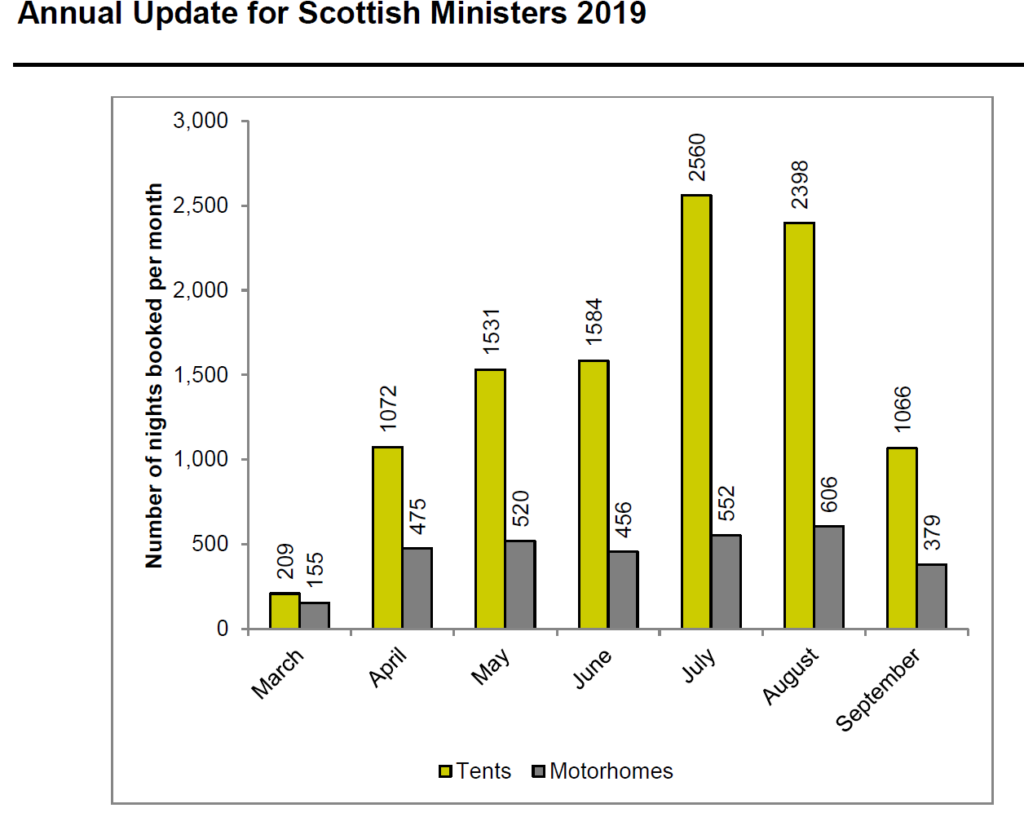
One of the main justification for the camping byelaws used by the LLTNPA was that there were too many people camping on the loch shores. Let’s set aside the fact that there were only ever high numbers camping for short periods of the year and forcing people into permit areas increased environmental impacts there, the LLTNPA is now trying to portray the increase in numbers booking permits over the last year as a success!
“It was encouraging to see that even without an exceptional summer that there was an increase in people coming out to camp in and enjoy the National Park in 2019.”
This is fundamental. There is no better way to connect people with nature than camping. Its good for people’s mental and physical health and has far less impact on the environment than the developments the LLTNPA is approving all round our Loch Shores (an expanded Cameron House just this week was given planning approval). So why, if the reported increase in numbers camping over the last year is a good thing, is the LLTNPA Board continuing to support the camping byelaws?
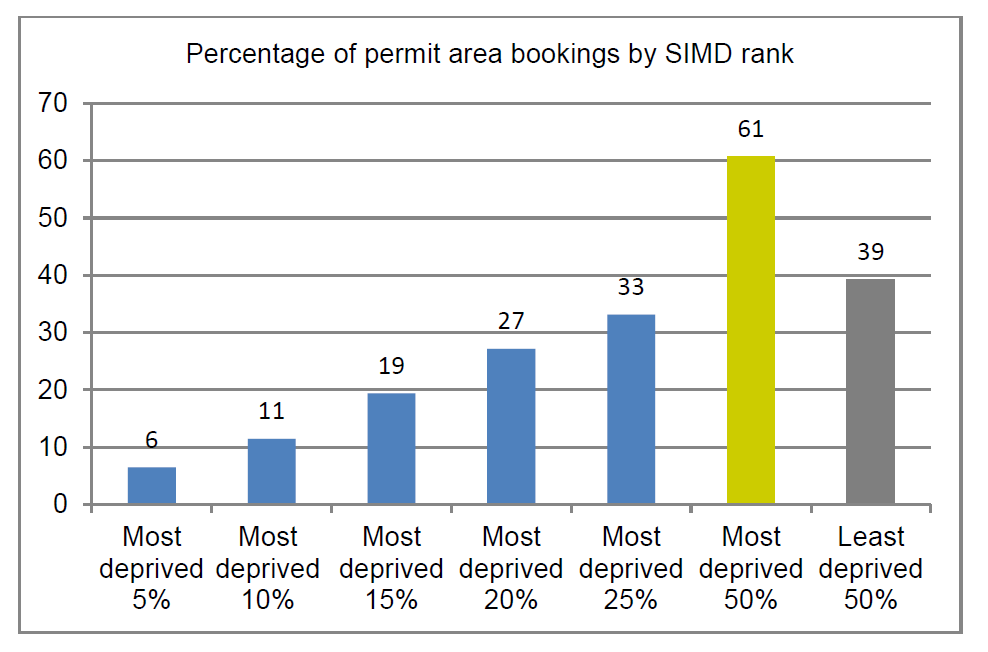
After praising the data in the report, the Board Members at the meeting 10 days ago failed to pick up on the fundamental point about why is the LLTNPA still effectively trying to restrict the numbers of people camping. Instead they honed in on data about the social background of campers and whether there was equality of opportunity in camping (see chart above). For example:
- Claire Chapman wondered if Scouts were use the campsites (often used now by Duke of Edinburgh Expeditions) and spoke of opportunity to widen out use to Youth Groups and Mental Health Groups.
- Ronnie Erskine wondered if the data showed “we are not hitting the right areas”
- Heather Reid thought it would be interesting to do research on this
This completely missed the central issue. The majority of people camping in the National Park have always come from the Glasgow conurbation, which has long experienced serious poverty and in the modern parlance has the greatest concentration of areas of multiple deprivation in the UK. The camping byelaws – though an attack on everyone’s right of access – were always going to affect people from Glasgow and poorer people most. The camping byelaws, however, now impact on poorer people even more disproportionately because they are no longer enforced against campervanning (a good thing) and generally it is better off people who own campervans. These facts are nicely illustrated by the map of the UK above showing the post codes of people who have booked permits.
That there are less bookings from the most deprived 10% of areas in Scotland, which so exercised Board Members at the meeting, should come as no surprise to them. The poorest people are those least likely to access the countryside, whether camping or not. One reason the Loch Lomond and Trossachs National Park was created was to enable more people from the Glasgow conurbation to enjoy the countryside – a very worthy aim. The opposite has happened and the LLTNPA has a major responsibility for this. In terms of outdoor recreation, its not just the camping byelaws:
- its the location of the new campsites – how do people without cars get to the Loch Chon campsite for goodness sake?
- its the failure of the LLTNPA to argue against the collapse in outdoor education provision (ALL children in Strathclyde used to get treated equally and get a week in an outdoor education centre)
- its the failure of the LLTNPA to improve public transport connections which would allow people without cars to walk up hills like Ben Lomond.
On their logic, if the LLTNPA Board really want to increase the number of bookings from the poorest areas, the first thing they could do is drop the charges for permits for anyone booking from those areas (as they have done for youth groups). That, however, would be to return to freedom to roam and access rights which don’t discriminate against anyone.
What needs to happen
The Annual Update Report to Ministers contains plenty of information to show that the camping byelaws are not working and are fundamentally flawed. It could have provided an opportunity for the LLTNPA to signal a change in direction but all the overwhelming message from the Board Meeting which approved it is that Board Members still don’t understand the issues or, if they do, are not prepared to do anything about it.
It is therefore going to be up to recreational and other organisations and all who enjoy camping or campervanning in the National Park to push an alternative arguments with Scottish Ministers. Involving politicians, most of whom have shied away from getting involved, would be very helpful. There is a need to make elected representatives – of all political colours – in the Glasgow conurbation aware that the byelaws effectively discriminate against their constituents with adverse consequences for people’s physical and mental health. More widely, there is the argument that the LLTNPA, instead of wasting enormous resources on what is a relatively minor issue, should start focussing its efforts on tackling the climate emergency.

1 Comment on “The LLTNPA’s annual update on the camping byelaws cannot hide their failure”